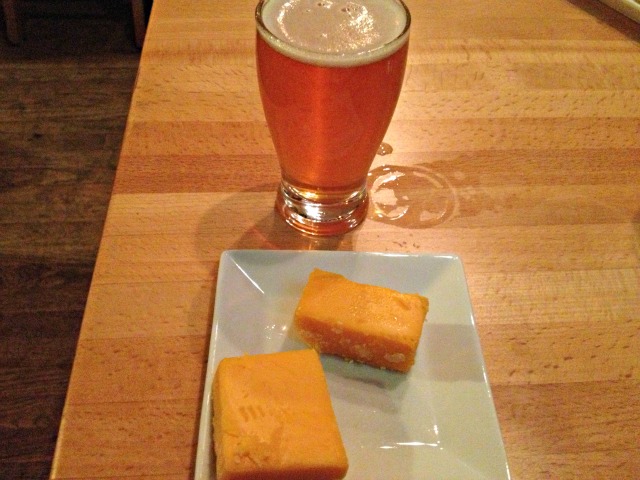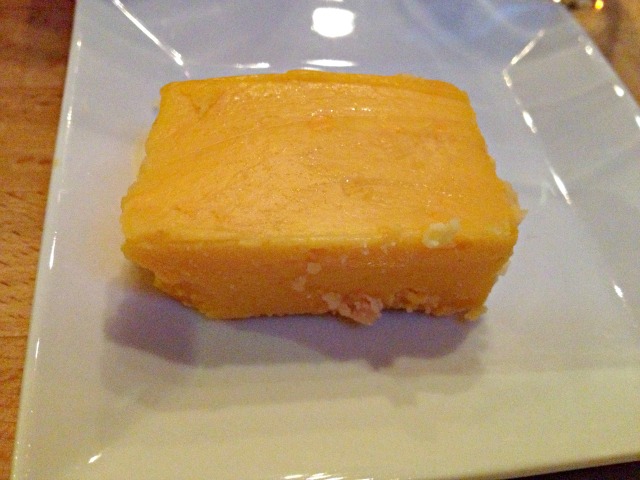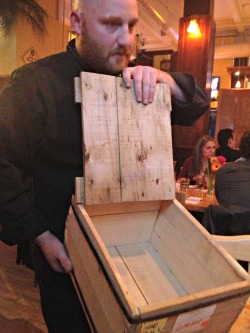How Does 40-Year-Old Wisconsin Cheddar Taste?
By Chuck Sudo in Food on Oct 8, 2012 6:00PM

$40-year-old Wisconsin cheddar: some expensive cheese spread. (Photo credit: Chicagoist/Chuck Sudo)
“For me, 40-year-old aged cheddar is what I like to call a personal wormhole,” Wisconsin Cheese Mart’s Trevor Smith said Saturday night. “I wasn’t born in 1972 so this is an exciting experience for me."
I was among a group of guests at the Milwaukee cheese shop and bar Smith Saturday in what was called the “Ultimate Vertical Cheddar Tasting.”The highlight of the tasting were samples of cheddar originally made in 1972 and 1984 by Ed Zahn of Z’s Cheese Shop in Oconto, Wisc. Zahn discovered the cheese during a spring peek inside one of his coolers; it’s believed to be the oldest collection of edible cheese recorded.
Zahn, who attended a Saturday afternoon cutting of the 28-year-old cheese, told Madison.com he was more embarrassed than anything by the discovery. It didn’t, however, stop him from selling the 40-year-old cheese at over $40 a pound once he determined it was edible. Smith said Saturday night the 40-year-old cheese was particularly popular among fishermen.
“They said it made amazing bait for catfish and trout,” he said.
Wisconsin Cheese Mart owner Ken McNulty, upon hearing of the discovery, bought Zahn’s remaining inventory and decided to use the 28- and 40-year-old cheddars in a vertical tasting with five-year-old and 12-year-old cheddar.

Five-year-old cheddar (bottom) and the 12-year-old cheddar. Note the larger crystal formation on the 12-year-old vintage. (Photo credit: Chicagoist/Chuck Sudo)
We started with the five-year-old cheddar and noticed its pronounced sharpness, dryness and the slightly crumbly texture of the cheese, which was paired with a small serving of Lakefront Brewing’s India Pale Ale. Cheddar cheese and bitter beers like IPAs make a perfect pairing as the beer's spicier characteristics complements the sharpness of the cheese.
This flavor profile progressed with each cheese and drink pairing. McNulty said cheddar tends to get creamier as it ages. Smith added that the cheese also develops salt and lactic acid crystals, which made for a crunchy bite as we progressed in the tasting. The 12-year-old cheese was paired with Paul Hobbs “Crossbarn,” a fruit-forward Napa Valley Cabernet with pronounced spice notes. The cheese itself was drier and more crumbly than the five-year-old, with only a slight uptick in the sharpness.

The flavor and texture of the 28-year-old cheddar was light years beyond the 12-year-old vintage. (Photo credit: Chicagoist/Chuck Sudo)
From the 12-year-old cheese we made a bold leap forward to the 28-year-old cheddar, paired with a serving of Warre Vintage Port. The most noticeable aspect of this pairing was the aroma of the cheese, which I could smell from a few feet away. The crystallization on the surface and inside the cheese was also more pronounced. The texture of this cheese was decidedly creamier inside than the 12-year-old version, and its sharpness was light years beyond the previous two vintages. Smith said this cheese was “almost impossible to cut.”
Finally, we reached the big one. The 40-year-old cheddar was so creamy it began to melt in my mouth after I bit into it. The crystals on the surface and inside the cheese made for an amazing contrast in textures and the sharpness of the cheese worked perfectly with some 17-year-old Kentucky bourbon.

Wisconsin Cheese Mart's Trevor Smith holds a box used to age 12-year-old cheddar. (Photo Credit: Chicagoist/Chuck Sudo)
Zahn was able to age these cheeses through a combination of ignorance and luck. Had he kept track of his inventory it’s highly likely this cheese would never have survived as long as it did in his cooler. Another factor is the acidity level of the raw milk used in making the cheese. Trevor Smith told guests at the tasting that the grass on which Wisconsin dairy cows graze contains a lower acidity content, which allows them to age at a slower pace as cheddar from other regions. He also had the wooden boxes used to age cheddar available for guests. "Cheese makers work to ensure the wood and milk used to make the cheese are from the same area," he said. This gives the cheddar a distinctive "footprint" identifying area where the cheese was made.